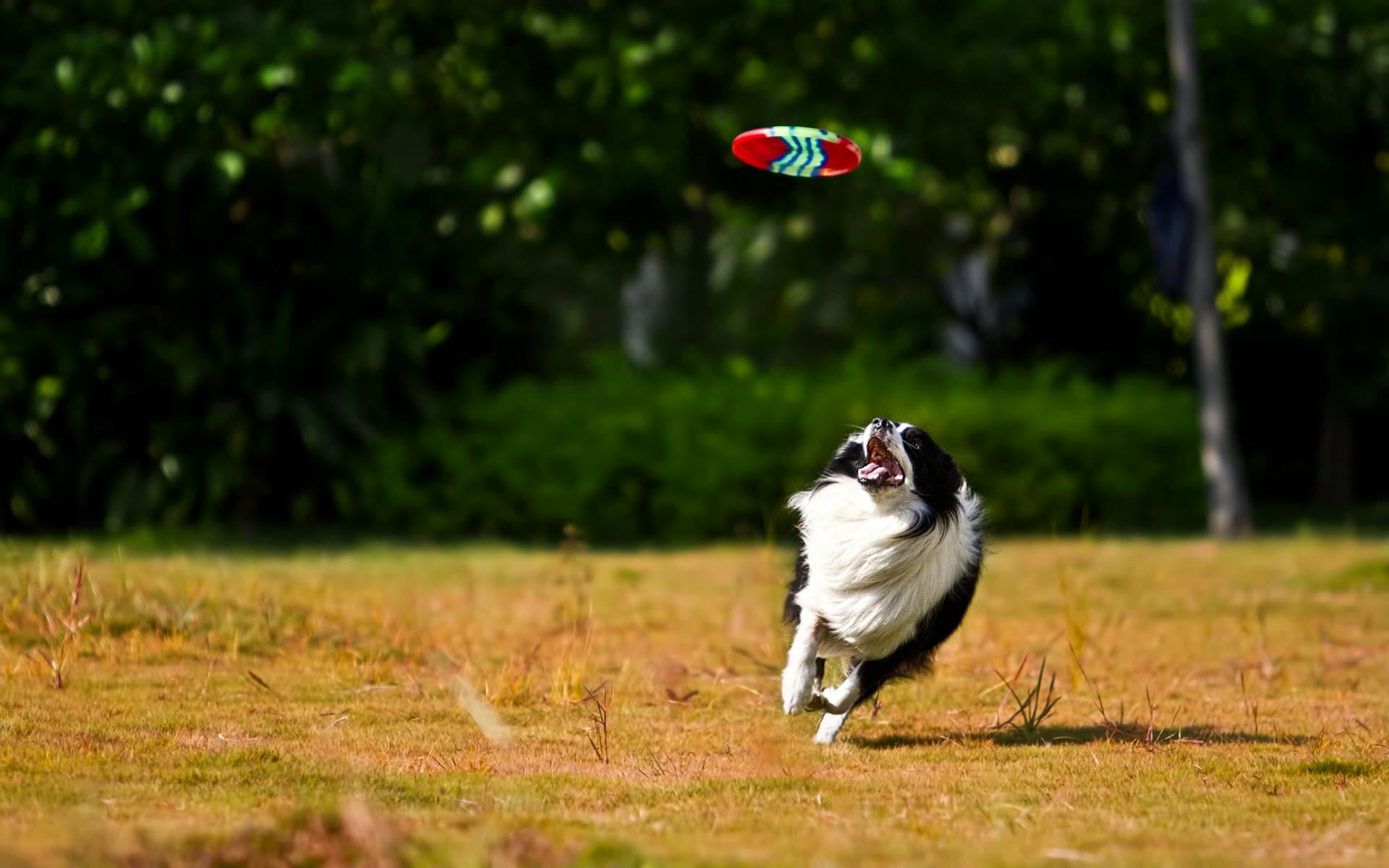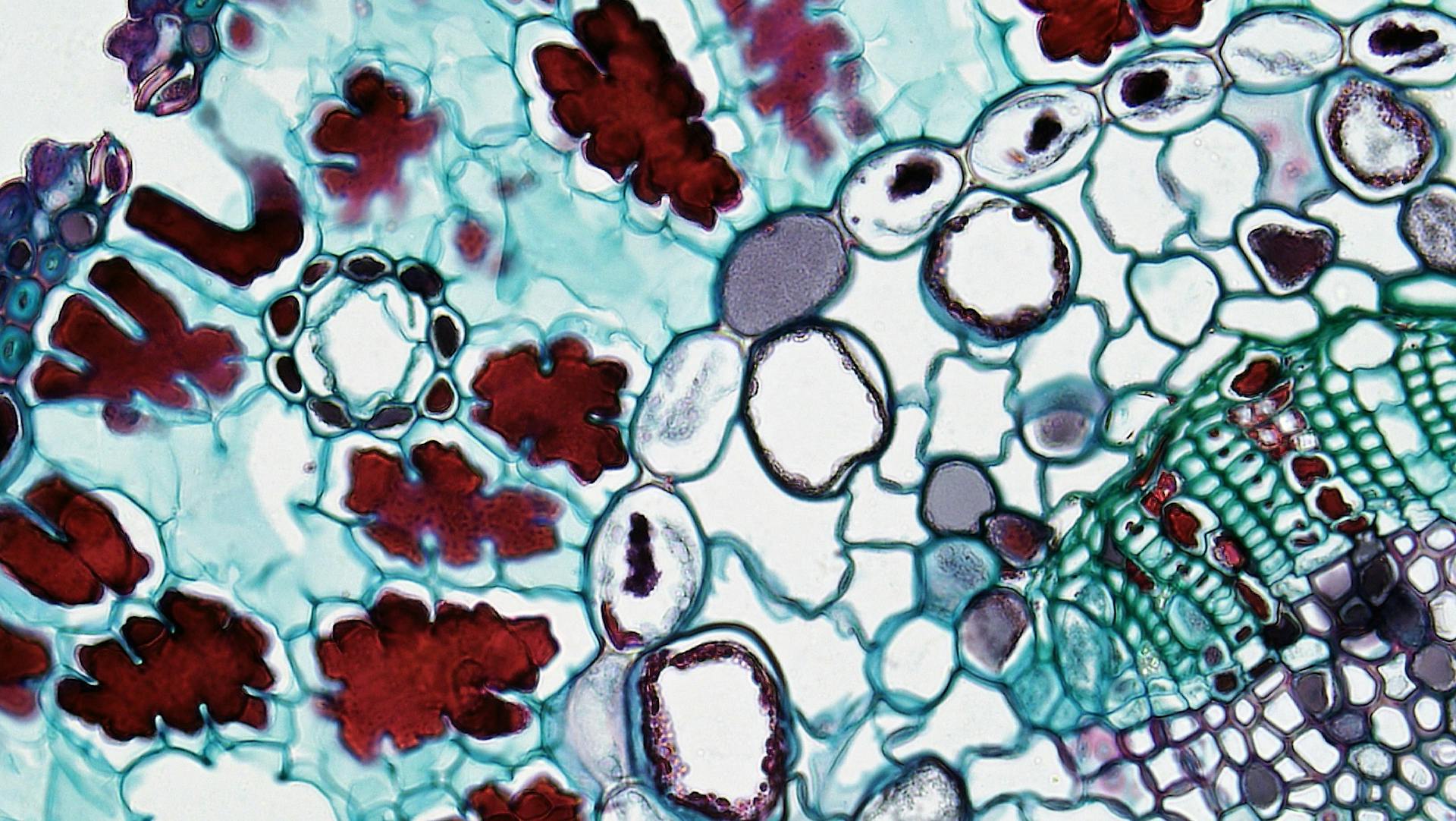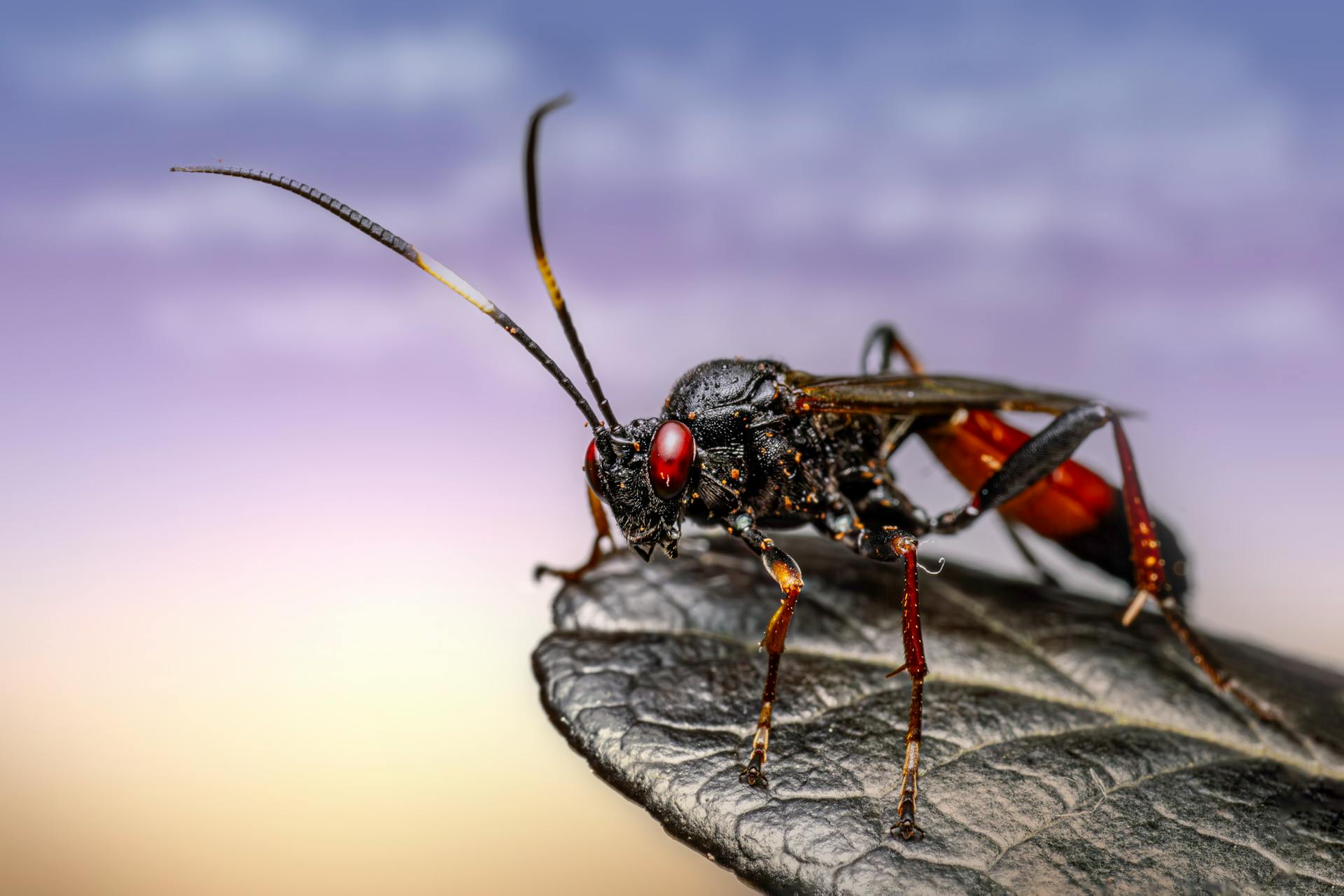
Chronic superficial keratitis, also known as panus, is a common eye condition affecting canines. It's characterized by a chronic, superficial inflammation of the cornea.
The condition is often seen in breeds such as the Weimaraner, Doberman Pinscher, and Greyhound. These breeds are prone to the condition due to their genetic makeup.
The symptoms of chronic superficial keratitis can be subtle and may not be immediately noticeable. They can include a hazy or cloudy appearance of the cornea, a slight squinting of the eye, and a sensitivity to light.
The condition can progress over time, leading to a more serious inflammation that may cause pain and discomfort for the dog.
Readers also liked: Pigmentary Keratitis Shih Tzu
Diagnosis
Diagnosis can be made based on the clinical appearance of corneal lesions, which are often sufficient for a Chronic Superficial Keratitis (CSK) diagnosis.
However, it's not uncommon for CSK to be mistaken for other conditions such as pigmentary keratitis, keratoconjunctivitis sicca, chronic irritation, and/or chronic granulation tissue from previous corneal wounds.
The key to diagnosing CSK lies in identifying the progressive vascular and inflammatory changes seen in the cornea, which can appear as a thickened, "cobble-stone" appearance, often accompanied by depigmentation of the leading edge of the third eyelid.
Intriguing read: Pancreatitis in Senior Dogs
Histopathologic Diagnosis & Pathogenesis

Histopathologic diagnosis of CSK reveals fibrovascular tissue in the corneal stroma accompanied by lymphocytes and plasma cells.
Infiltrating CD4+ lymphocytes are the predominant cells found in patients with CSK, suggesting an immune-mediated pathogenesis.
An increase in major histocompatibility complex class II antigen expression has been identified in the central corneal epithelium and stroma in dogs with CSK, indicating an autoimmune nature of the disease.
Dogs with a specific major histocompatibility complex class II risk haplotype are 2.7 times more likely to develop CSK, and those that are homozygous for this haplotype are 8 times more likely.
High altitude and increased exposure to sunlight can intensify clinical signs in dogs that may have a genetic predisposition for developing CSK.
Clinical Diagnosis
Clinical Diagnosis is often straightforward, as the signalment and clinical appearance of corneal lesions are usually enough for a diagnosis of Chronic Superficial Keratitis (CSK).
However, it's essential to rule out other conditions that can mimic CSK, such as pigmentary keratitis, keratoconjunctivitis sicca, chronic irritation, and chronic granulation tissue from previous corneal wounds.
CSK typically starts at the ventrolateral aspect of the cornea, which can be an important clue in making a diagnosis.
Dogs of any size and breed can be affected by CSK, but large breeds like German shepherds, shepherd crossbreeds, border collies, and greyhounds are more commonly affected.
The age of onset is a crucial factor in determining the prognosis, with young dogs (1-5 years old) often experiencing more severe and rapid progression of the condition.
Treatment and Management
CSK can be controlled through medical or surgical means, but it cannot be cured. The goal of treatment is to stall disease progression.
Lifelong therapy is necessary for CSK, and disease severity and prognosis depend on factors such as age of onset, altitude, sun exposure, and genetic predisposition.
Treatment typically includes topical corticosteroids or topical cyclosporine, but any treatment only controls and reduces inflammation rather than providing a cure.
Topical corticosteroids may be used in combination with other eye medications, and in extreme cases, surgery or radiation therapy may be necessary.
See what others are reading: Lick Granuloma Treatment Dog
Regular eye exams are crucial in identifying any reoccurring flare-ups once the CSK is under control.
Dogs with CSK will require ongoing, lifelong medication to prevent lesions on the cornea from returning.
Here are some common treatment options for CSK:
- Topical corticosteroids or cyclosporine
- Strontium-90 radiation therapy
- Canine sunglasses to protect the eyes from ultraviolet radiation
Long-term control of mild-to-moderate cases can often be managed with topical therapy, such as cyclosporine or tacrolimus.
Causes and Risk Factors
Chronic superficial keratitis, or CSK, is an immune-mediated disease that affects the cornea of dogs. It's characterized by an infiltration of white blood cells into the superficial stroma of the cornea.
The exact cause of CSK is not known, but it's thought to be hereditary and influenced by genetic factors. Certain breeds, such as German shepherd dogs, shepherd crossbreeds, border collies, and greyhounds, are more prone to the condition.
Some factors that contribute to the development of CSK include exposure to ultraviolet light, which is more prevalent at higher altitudes and has a seasonal variation with most cases occurring in the summer. Additionally, immune-mediated inflammation and underlying eye conditions can also play a role.
Here are some key factors that can contribute to the development of CSK:
- Exposure to ultraviolet light
- Immune-mediated inflammation
- Underlying eye conditions
Clinical History & Signalment
Large breeds, such as German shepherd dogs, shepherd crossbreeds, border collies, and greyhounds, are predominantly affected by this condition.
Dogs of any size and breed can develop CSK, but it's more common in certain breeds.
The age of onset is a crucial factor in determining the prognosis, with young dogs typically experiencing a rapid progression of the condition between 1-5 years of age.
Older dogs, on the other hand, may experience less severe lesions if they develop CSK later in life, after 4-5 years of age.
On a similar theme: Can Dogs Develop Allergies Later in Life
Causes of Pannus
Pannus in dogs is a complex condition, and its exact cause is still not fully understood. However, it's thought to be primarily a hereditary condition that appears as a dog ages.
Pannus is typically found only in certain dog breeds, although it can appear in any breed. Some breeds that are more likely to develop pannus include German shepherds, Belgian tervurens, border collies, and greyhounds.

Certain factors can contribute to the development of pannus, including large amounts of sunlight exposure, immune-mediated inflammation, and underlying eye conditions. Exposure to airborne irritants, high altitudes, and entropion (eyelids rolled inward) may also play a role.
Here are some key factors that can contribute to the development of pannus:
- Large amounts of sunlight exposure
- Immune-mediated inflammation
- Underlying eye conditions
- Exposure to airborne irritants
- High altitudes
- Entropion (eyelids rolled inward)
It's worth noting that pannus can be more severe in dogs that have a genetic predisposition to the condition, and that ultraviolet light may modify cornea-specific antigens, which can initiate the cell-mediated inflammation.
Symptoms and Signs
Chronic superficial keratitis (CSK) is a condition that affects the eyes of dogs, and it's essential to recognize the symptoms to get your furry friend the proper care.
The condition typically progresses rapidly in young dogs, between 1-5 years of age, and lesions may be less severe in animals affected later in life.
Bilateral progression is common, but the lesions are not symmetrical and are not painful.
Pigmentation and vascularization of the cornea are signs of CSK, with the lesions usually first appearing at the lateral (temporal) limbus.
Severe cases can cause blindness, and while CSK is usually identifiable by the appearance of the eye and the breed of the affected dog, cytology will reveal the presence of lymphocytes and plasma cells.
Some common symptoms to watch for include:
- Redness and tearing
- A grayish-pink film on the eye(s)
- Cornea pigmentation
- Cornea opacity
- Tearing and redness
The third eyelid may become thick and inflamed, and both eyes are typically affected, but one may appear worse than the other.
Canine Prognosis
Chronic superficial keratitis, or CSK, is a condition that cannot be cured, but can be controlled with medical or surgical means.
Unfortunately, this means that owners will need to commit to lifelong therapy to manage their dog's condition.
Treatment protocols have not been established, and the goal of therapy is to stall disease progression, not to cure it.
Factors such as age of onset, altitude, sun exposure, and genetic predisposition all play a role in determining disease severity and prognosis.
As a result, owners should be prepared for ongoing treatment and regular veterinary check-ups.
In addition to medical treatment, owners can also take steps to protect their dog's eyes from further damage, such as using canine sunglasses to prevent UV radiation exposure.
Regular eye exams are crucial in identifying any reoccurring flare-ups once the condition is under control.
Dogs with CSK will require ongoing, lifelong medication to prevent lesions on the cornea from returning.
With close monitoring from a veterinarian and diligent at-home care, most dogs respond well to treatment and can lead happy, healthy lives.
Epidemiology and Impact
Chronic superficial keratitis is a common eye issue in certain breeds of dogs.
German Shepherds are particularly prone to this condition, making up a significant portion of cases.
Belgian Tervurens, Greyhounds, Siberian Huskies, Australian Shepherds, and Border Collies are also at risk, although to a lesser extent.
For more insights, see: Autoimmune Disease in German Shepherds
Pannus Impact on Dog's Eyes Removed
Pannus is a condition that affects a dog's eyes, causing a grayish-pink film to cover the eye. This film can lead to the cornea becoming opaque as the disease progresses.
It's common for pannus to affect both eyes, although it can be present in just one eye. In fact, it's more common for it to be found in both eyes.
Pannus can cause vision problems and discomfort for dogs. The condition is often associated with certain dog breeds, but it can appear in any breed.
Some factors that can contribute to the development of pannus include exposure to airborne irritants, high altitudes, and large amounts of sunlight exposure. Entropion, a condition where the eyelids roll inward, can also be a contributing factor.
Here are some common factors that contribute to pannus in dogs:
- Exposure to airborne irritants
- High altitudes
- Large amounts of sunlight exposure
- Entropion (eyelids rolled inward)
- Immune-mediated inflammation
- Underlying eye conditions
Epidemiology
Chronic superficial keratitis is a common eye condition found in several breeds of dogs.
German Shepherds are the most commonly affected breed, followed by Belgian Tervurens, Greyhounds, Siberian Huskies, Australian Shepherds, and Border Collies.
This condition is more prevalent in these breeds due to their genetic predisposition.
Sources
- https://www.cliniciansbrief.com/article/chronic-superficial-keratitis-dogs
- https://www.memphisveterinaryspecialists.com/site/blog-cordova/2023/11/15/pannus-dogs
- https://pubmed.ncbi.nlm.nih.gov/25286670/
- https://en.wikipedia.org/wiki/Chronic_superficial_keratitis
- https://www.acvo.org/common-conditions-1/2018/2/2/pannus
- https://pubmed.ncbi.nlm.nih.gov/10502491/
- https://www.animaleyeguys.com/site/blog/2024/02/15/pannus-dogs
Featured Images: pexels.com

